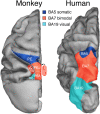Vision for action: thalamic and cortical inputs to the macaque superior parietal lobule
- PMID: 34524542
- PMCID: PMC8541979
- DOI: 10.1007/s00429-021-02377-7
Vision for action: thalamic and cortical inputs to the macaque superior parietal lobule
Abstract
The dorsal visual stream, the cortical circuit that in the primate brain is mainly dedicated to the visual control of actions, is split into two routes, a lateral and a medial one, both involved in coding different aspects of sensorimotor control of actions. The lateral route, named "lateral grasping network", is mainly involved in the control of the distal part of prehension, namely grasping and manipulation. The medial route, named "reach-to-grasp network", is involved in the control of the full deployment of prehension act, from the direction of arm movement to the shaping of the hand according to the object to be grasped. In macaque monkeys, the reach-to-grasp network (the target of this review) includes areas of the superior parietal lobule (SPL) that hosts visual and somatosensory neurons well suited to control goal-directed limb movements toward stationary as well as moving objects. After a brief summary of the neuronal functional properties of these areas, we will analyze their cortical and thalamic inputs thanks to retrograde neuronal tracers separately injected into the SPL areas V6, V6A, PEc, and PE. These areas receive visual and somatosensory information distributed in a caudorostral, visuosomatic trend, and some of them are directly connected with the dorsal premotor cortex. This review is particularly focused on the origin and type of visual information reaching the SPL, and on the functional role this information can play in guiding limb interaction with objects in structured and dynamic environments.
Keywords: Area PEc; Area V6; Area V6A; Dorsal visual stream; Goal-directed arm movement; Sensorimotor integration.
© 2021. The Author(s).
Conflict of interest statement
The authors declare that they have no conflict of interest.
Figures








References
Publication types
MeSH terms
Grants and funding
LinkOut - more resources
Full Text Sources

